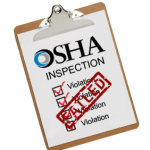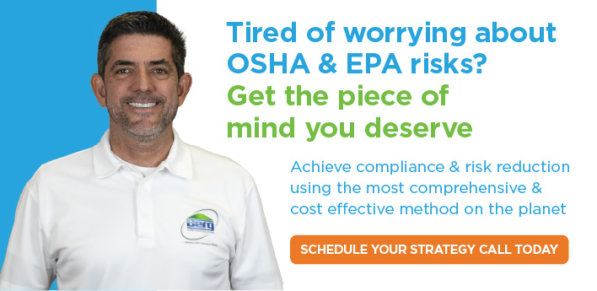Learn all about the OSHA inspection process and how to manage it in the comprehensive blog post
It’s the call that every small business owner and manager dreads, “OSHA is in the lobby.” If that happens, you need to be prepared because an OSHA inspection can be incredibly disruptive, stressful and expensive for you and your staff if you’re not ready.
This blog post is designed to help you do exactly that, so read on….
The content of this blog post is based upon standard guidance that anyone can find by searching the internet, however the majority of the post is based upon our real life past experience helping our clients through the OSHA enforcement process, from the arrival of the OSHA inspector all the way through the “informal conference” process to final resolution. We’ve helped many companies manage this process and are available to help your’s too by CLICKING HERE.
2016 OSHA Fine Increases:
In a recent blog post, we discussed OSHA’s 78% fine increases that went into effect in August of 2016.
Since that original blog post, fines have continued to increase every year to account for inflation and as of 2021 here is the current fine schedule:
- Serious Violations: Maximum fine of $13,653 per violation
- Repeat & Willful Violations: Maximum fine of $136,532 per violation
In that blog post we talked about what can trigger inspections, the probability that your company gets inspected, some of the most common violations cited to Texas manufacturers and how much those citations could end up costing your company. If you missed and want to learn more, click here.
Key OSHA Inspection & Enforcement Trends You Need To Be Aware Of:
- OSHA enforcement efforts are currently at an all time high with no signs of slowing down, and so the probability of your company getting inspected is higher than ever. This risk has been elevated by the Biden administration’s stated commitment to workplace health and safety.
- Given OSHA’s fine increases, it’s now expected that the average fine from a single, comprehensive inspection will range between $37,000 – 90,000. For companies who lack verified and complete health and safety programs, those fines could end up exceeding $100,000 or more!
- Even companies with good relationships with local OSHA officials can get inspected, and often do.
- Many companies end up treating safety and enforcement inspections too casually, which can end up costing them significantly.
- Enforcement inspectors will use all lawful means possible to prosecute violators. If they see a violation, they have to cite it, and you cannot “talk your way out of it.”
- Employers have rights regarding OSHA enforcement actions, and need to understand and protect those rights in order to avoid additional damages, costs and liabilities.
Given these circumstances, it’s critical that your company get prepared and develop an action plan in the event that OSHA knocks at your front door. We hope that this blog post provides a good head start….
Basic Preparation Tips:
- Assign a staff manager and a backup to manage potential inspections and train them on how to manage an inspection (see guidance on how to manage inspections below). If you don’t have an internal safety manager, then assign the manager or staff member who is most familiar your company’s health and safety compliance programs.
- One of the keys to preparation is knowing exactly where all relevant health and safety documents are stored, and how to access them, whether they’re electric or hard files. There are few things worse than not being able to find requested documents quickly and easily during an inspection. The quicker your company can produce requested information, the better off you’ll be. Believe me!
- Be prepared to show strong evidence of “management commitment” towards safety is critical. A great way to do that is to draft a formal company health and safety policy, have the owner or most senior level manager sign it, and hang it on the wall in the front lobby. You’d be surprised how powerful a comprehensive written policy, with an actual ink signature, can be. Not only for potential OSHA inspectors, but also for employees and visitors. A word of caution: the policy statement needs to be backed up by solid health and safety programs and ongoing management at the company. If your company doesn’t have this, then a written policy is meaningless and can backfire badly in the event of an inspection.
- If you don’t currently have an updated OSHA compliance program, then do not put it off any longer: We can help.
How To Manage an OSHA Inspection:
- If an inspector shows up, begin by requesting the inspector’s credentials. A business card isn’t necessarily enough, and if there’s any doubts or concerns, don’t hesitate to call the local OSHA office to confirm the identity of an inspector. (FYI, just this month OSHA distributed a memo stating that a fraudulent person claiming to be an OSHA inspector was inspecting companies throughout Texas!)
- Keep in mind that your company has the right to resist the start of an inspection, but this is typically not advised since doing so will likely result in a much more intensive “wall to wall” comprehensive inspection soon after. This should only be done if there a extenuating circumstances that might result in significant fines or citations. However if those circumstances can’t be quickly corrected (before OSHA returns with a warrant), then it’s probably not worth pursuing.
- If your company has a 3rd party health and safety consultant, then call them immediately and ask the inspector if he or she can wait until the consultant arrives before beginning the inspection. Normally they’ll wait up to 30 minutes, but then will proceed with the inspection regardless. OSHA inspectors are always looking for evidence of “management commitment” and letting the inspector know that money is being spent on outside expert help will almost always work in favor of the company.
- If your company has an attorney, alert them as well.
- Typically, the inspector will conduct a brief “opening conference” where they explain the purpose (“trigger”) of the inspection and how they plan on proceeding.
- If the enforcement officer doesn’t do this formally, make sure to ask what triggered the inspection and how the inspector plans to manage the inspection. Triggers can include employee complaints (or complaints from others such as employee relatives or even police or EMS), “drive by’s,” National Emphasis Programs, high accident or injury rates, Etc. Request any relevant documentation to support the trigger event.
- It’s important to know that if the inspection was triggered by a complaint, this is potentially “good news” since the inspection will likely be relatively simple and short because they typically just focus on the complaint issue and nothing more. This is normally the case, unless the inspector happens to notice other serious hazards or if the company acts defensive or unprofessional. If either, or both occur, the scope of the inspection could quickly escalate. Make sure to ask for a copy of the complaint AND to only show the inspector the location of the complaint issue. If possible, route the walk toward that area away from other potentially hazardous or suspect areas of your facility, since the inspector may notice other problems along the way. Sometimes it’s unavoidable, but it’s best to limit their overall access and vision if at all possible in order to minimize risk and liability.
- If on the other hand, the inspection is triggered by a National Emphasis Program (or “NEP”) or high injury rates (i.e.: High TRIR or DART scores), then the inspection is likely to be “comprehensive” in nature. This is not good news, since these inspections typically result in the highest number of citations and fines. If so, the inspection will likely last a minimum of one day, but probably more, and the scope will include not only a wall to wall walk through of your facility, but they’ll also scrutinize written documentation such as your company health and safety manual, employee training records, hazard assessments, and other record keeping requirements such as your OSHA 300 logs or health testing reports. Often times these inspections will include more than 1 enforcement officer. If your company isn’t prepared and doesn’t have these documents, the citations will likely be numerous and fines excessively high. We’ve helped a client through one of these comprehensive inspections and it was incredibly time consuming, disruptive and costly for the company (read more about this in Part 2 of this blog post). Again, this underscores the need to be prepared!
- If the enforcement officer doesn’t do this formally, make sure to ask what triggered the inspection and how the inspector plans to manage the inspection. Triggers can include employee complaints (or complaints from others such as employee relatives or even police or EMS), “drive by’s,” National Emphasis Programs, high accident or injury rates, Etc. Request any relevant documentation to support the trigger event.
- Here’s some pointers on how to manage the inspection once it begins:
- Make note of the names of all people involved with the inspection, including OSHA personnel as well as your company staff.
- Always be cooperative and professional, but only answer the specific questions asked, and never volunteer additional information.
- Make detailed notes of everything said and done during the inspection.
- It’s not advised to allow tape recording.
- Use the most direct route to the inspection area (assuming that OSHA has requested access to a specific area), avoiding other areas of the plant floor whenever possible.
- Try to duplicate everything the inspector does:
- If they take photos, then your staff should take photos of the same items.
- Duplicate any comments and/or reporting.
- Pull any duplicate samples that the inspector might pull (chemical samples, etc).
- Label any items that are photographed or commented on.
- Always be sure to ask the inspector what they’re noting and citing while they’re doing so. Waiting until later will likely result in a less detailed response not to mention missing the potential opportunity to defend the company’s position.
- If you’re able to correct any noted violations during the inspection, make sure to do so on the spot, and make note of those corrections and take photos
- At the end of the inspection, the enforcement officer should conduct a “Closing Conference” where they should summarize any noted citations, explain the next steps, etc.
- If no closing conference is offered, then be sure to request one.
- Do the following during the closing conference:
- Inquire as to which, if any violations/citations were noted during the inspection.
- Make sure to ask detailed questions about any citations so that you’ll fully understand the problem and how to fix it.
- Be sure to ask the severity of each proposed citation: “Serious,” “Willful,” “Repeat” (if the company has been cited prior by OSHA) “Other Than Serious,” Etc. This will help you to determine the likely fine amount.
Keep in mind that the enforcement officer can’t actually issue citations during the inspections. They can only make recommendations, which will later undergo extensive review and vetting by more senior OSHA officials, before final citations can be issued. THIS PROCESS CAN TAKE UP TO 6 MONTHS! More on this in part 2 of this blog post).
- If possible, explain to the inspector how the company plans on correcting any noted deficiencies and when those corrective actions will occur. Demonstrating a “proactive” attitude and plan to quickly fix identified violations and hazards is critical!
How Can The Inspector Impact The Outcome?
On a side note, it’s important to understand that the quality, scope, focus and duration of any OSHA enforcement inspection is highly subjective and largely dependent upon the assigned enforcement officer. The truth is that enforcement inspectors “come in all shapes and sizes.” Some are extremely professional and knowledgeable, while quite frankly, others are not. We’ve heard many such comments from companies over the years.
For example, an inspector will often focus on hazards that they understand and are comfortable with: if they’re knowledgeable about machine guarding issues, then they’ll likely focus on those hazards and cite as many relevant violations as possible. On the other hand, if they’re more knowledgeable about health hazards, such as chemical and noise exposures, then they’re likely to focus on those (and walk right past blatant machine guarding violations that the “other” inspector would have nailed).
Unfortunately, other more experienced and qualified inspectors with a well-rounded understanding of hazards, will be able to cite a wide range of problems. Inspections that involve multiple officers will obviously result in the most wide ranging and numerous citations.
Aside from technical knowledge, inspectors also bring their own personalities to the inspection, and companies will be wise to make note of those qualities and respond appropriately.
Again, the best overall guidance is to always be respectful and professional during the inspection, but don’t be afraid to defend your position (but only do so once or twice on any given issue, never argue, and instead just make note of any objections in your report).
Closing Thoughts & Considerations:
In summary, there is much preparation, much to consider and a lot at risk when it comes to managing OSHA enforcement inspections. Get prepared and train your staff on how to manage these interactions, doing so might just end up helping your company avoid some major fines and penalties.
Of course, the best advice of all is to implement and maintain a comprehensive, OSHA compliant health and safety program at your company. Such a “program” should include detailed written policies and procedures, ongoing employee safety training (always documented), routine documented inspections followed up by corrective actions, creation of a company safety committee with monthly meetings, health testing (if required) as well as managing all OSHA record keeping requirements.
Companies who are able to manage all of these responsibilities demonstrate a strong culture of safety.
Companies who routinely manage health and safety obviously have the least to worry about and should have minimal problems managing OSHA inspections. Their staff will already understand the issues, respond appropriately, and OSHA inspectors will immediately “pickup” on this, and the process should go smoothly. That doesn’t mean that citations can’t or won’t be issued, but they’ll be minimized and associated costs reduced. Keep in mind that this scenario isn’t particularly common, especially with small companies, so when inspectors encounter it, they’ll acknowledge and appreciate the company’s efforts and commitment, and should respond accordingly.
Check back for Part 2 of this blog post where we discuss what happens after the inspection is completed. Many companies make the mistake of believing that the interaction is “over” once the inspector leaves, when in fact the follow up work and additional preparation for the company has just begun. Remember that OSHA has up to 6 months to issue final citations, and depending on the inspector’s recommendations, the company could have much to do in anticipation of, and follow up to the arrival of the citation letter. The arrival of the letter triggers significant deadlines and decisions that the company needs to understand and be prepared for in order to respond accordingly. Just because citations are issued doesn’t necessarily mean that they’ll stick, but the final outcome is largely dependent on how the company prepares and responds. This can be the difference between major or minor fine liabilities, not to mention future liabilities if citations go on your company record!
Of course, the best way to prepare for an enforcement inspection is to understand and manage OSHA compliance. Learn more here.
Or learn how to build a safety program from scratch here.
Need Help Getting Prepared for an OSHA Inspection or Getting OSHA Compliant?
CLICK HERE or call 512-457-0374
To Schedule Your Fee Consultation Today




